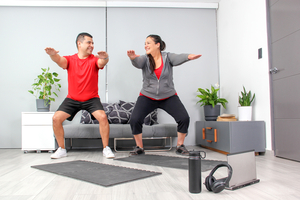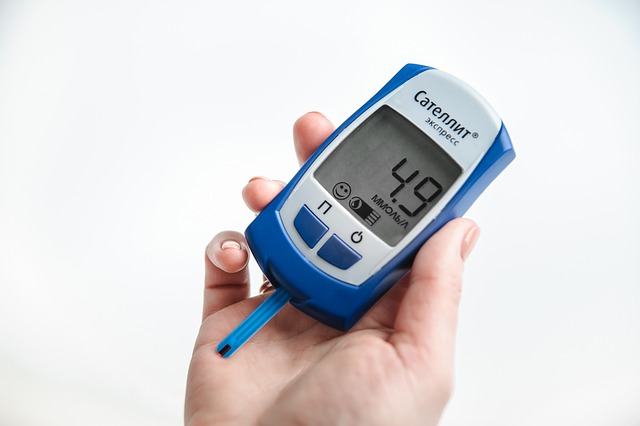In this article:
- Health for life describes choices you can make for better weight management and physical and mental health.
- Extreme diets and lifestyle overhauls can be overwhelming, while small steps to healthy living can be effective and sustainable for optimizing long-term wellness, managing weight, and controlling chronic conditions like prediabetes and hypertension.
- Six pillars of sustainable health are nutrition, physical activity, restorative sleep, stress management, self-monitoring, and medication adherence.
- Shift your mindset from temporary fixes and extrinsic motivation to long-term shifts and intrinsic motivation for lasting change.
- Lark can help you make sustainable changes to support health for life with 24/7 availability and personalized coaching.
Many people say they’re interested in health for life, but how can you get started? A sustainable healthy lifestyle and long-term benefits are not about crash diets or extreme fitness challenges. They’re about making one small change at a time that can become a habit. These habits can add up to a healthier lifestyle to help manage weight, prevent or manage chronic conditions, improve quality of life, and possibly boost longevity.
Keep reading to learn more about how to stay healthy with daily steps to better health. Healthy habits like eating a balanced diet, getting better quality sleep, including daily exercise, and reducing stress can help with weight management and optimal health across the lifespan.
How a “Health for Life” Approach Can Improve Weight, Chronic Conditions, and Mental Health
“Health for life” is a personal idea. Your goals for optimal health may be different than someone else’s goals based on where you are now and which health priorities you have. Consider your motivation for wanting a sustainable wellness plan.
Your goals may be related to weight management, for example, if you’re overweight or if you’ve lost weight and want to maintain your loss. More than two-thirds of Americans are carrying around extra pounds, and it’s not easy to lose weight. It’s even more difficult to keep weight off after losing weight. But small changes can make a big difference in your ability to manage weight for life, and Lark offers personalized coaching 24/7 to help establish habits.
Health for life could also involve preventing or managing chronic conditions. If you have prediabetes, for example, blood sugar control and diabetes prevention may be top areas of focus. Losing weight if you have extra pounds, eating a balanced diet, and being physically active are some of the best ways to prevent or delay the onset of type 2 diabetes. Lark’s Diabetes Prevention Program (DPP) is available 24/7 to help you reach those goals.
If you have diabetes or are managing high blood pressure and heart health, healthy habits like eating well, taking medications as prescribed, and meeting guidelines for physical activity are also critical. Balanced diets, good sleep health, and stress management can help you stay on top of these conditions for optimal health.
For some people, psychological health is a major emphasis of “health for life.” Stress management, social connections, and a sense of purpose can all be part of your sustainable habits for optimal health.
Why Long-Term Health Matters More Than Quick Fixes
When you’re deciding to commit to health for life, many people look for plans that can lead to quick results. Here are some examples of quick fixes and why they may fail or be harmful.
Small steps to better health can be easier and more effective than starting off too strong or extreme. When you adopt healthier behaviors, you’re likely to experience benefits like the following.
- Easier weight management
- Better control of blood sugar, blood pressure, and cholesterol levels
- Improved mood and clarity
As you practice taking small steps for health, you can gain resilience. You can develop an ability to keep trying, even if you’re not perfect in every choice every day.
Foundations of Health for Life
A strong foundation can support daily steps for better health. Instead of aiming for a complete overhaul all at once, try working on different areas related to a healthy lifestyle. This approach can break down your overall goals into manageable chunks. Here are some lifestyle pillars, how they relate to weight and health, and what you might try to incorporate into healthy routines.
Nutrition and Healthy Eating
A sustainable and nutritious diet offers long-term benefits for weight management, nutritional adequacy, and physical and mental health. Focus on balanced nutrition to include a variety of foods in your daily routine, support stable blood sugar and energy levels, and be able to enjoy your everyday meals as well as foods you may choose on special occasions.
Here are some guidelines for a healthy eating plan.
There are many balanced eating plans that can be healthy. Examples include a Mediterranean-style plan, the DASH (DietaryApproaches to Stop Hypertension) diet, and meal plans based on the US Dietary Guidelines.
Here are examples of small changes that can add up to big results for your health goals.
- Chew more slowly.
- Add 1-2 cups of water per day.
- Add almond milk instead of cream to coffee.
- Order dressing on the side instead of in the salad.
- Have mustard instead of mayonnaise on sandwiches.
- Fill half your plate with greens or other plain raw or cooked vegetables before serving yourself the rest of the foods at the meal.
Physical Activity
Exercise and activity support better weight management, heart health, and insulin sensitivity, not to mention mood and brain function.
Physical activity is for everyone, not just gym rats. You can be active and fit without ever going to a gym, though a gym is a good option, too. Daily physical activity can include gardening, household chores, and activity you do at work if it’s enough to raise your heart rate. Walking, dancing, and playing tag and sports with your children all count.
Here are some suggestions on movement for health. Always check with your healthcare provider about your ability to exercise safely and whether you have any restrictions on the type of exercises you can do.
Here are examples of small changes to fitness habits for a sustainable exercise routine..
- Add a 5-minute warm-up and 5-minute cool-down to your regular workout routine
- Set your phone alarm to go off every hour during the day to remind you to stand up and do some light activity to break up sitting time.
- Incorporate movement into family time, like doing squats while pushing your children on the swing, playing games like follow-the-leader and tag, or walking home from school together (or parking the car further from school so you can walk together to the car).
- Sign up for a group fitness class and commit to at least 2 months before you decide whether you like it or not.
Restorative Sleep
Sleep feels good and it’s good for you, so why don’t more people prioritize healthy sleep habits? Most Americans report being low on sleep at least once recently. Common reasons are trouble sleeping, lack of time to sleep, a poor sleep environment, and feeling guilty putting sleep ahead of other time-consuming activities like cleaning, working, and caregiving.
But restorative sleep is a critical part of recovery and metabolic health. Sleep deprivation can have devastating consequences. Here are some effects of sleep deprivation.
- Higher risk for diabetes or uncontrolled diabetes due to Increased insulin resistance and higher blood sugar levels
- Risk for weight gain or trouble losing weight due to Increased hunger and reduced satiety because of higher levels of the hunger hormone ghrelin and lower levels of satiety hormones like leptin
- Reduced muscle and other tissue recovery and repair due to lower hormonal production of testosterone and growth hormone
- Poorer immune function, leading to more infections and lower responses to vaccinations
- Irritability, trouble concentrating and remembering, and increased risk for vehicle and other accidents.
Here are some points on sleep for health.
Here are examples of steps to consider to improve sleep quality and duration.
- Be active during the day so you’re more tired and ready to sleep at night.
- Try deep breathing or progressive muscle relaxation every night when you go to bed to fall asleep faster.
- Write down 3-5 activities you can include in a bedtime routine, and try them out for a couple of weeks.
- If you’re often short on sleep, go to bed 30 minutes earlier than normal.
Stress Management and Mental Health
Everyone experiences stress, but too much stress for too long can be harmful to health. Stress hormones can raise blood sugar, increase fat storage, raise blood pressure, and impair quality of life. Still, healthy coping skills and other stress management techniques can reduce impacts of stress on health.
Here are some points on managing stress for health.
Here are examples of changes you can make for better stress management.
- Take a class or join a club or team for social engagement and fun.
- Be active every day, such as taking a walk.
- Have vegetables instead of chips for a snack.
- Identify stressors that you can’t change, and accept them.
Self-Monitoring
Self-monitoring is a way to stay on top of your healthy intentions. It improves self-efficacy, or how well you feel you can control your own choices and health. Self-monitoring can include weighing yourself, taking measurements like blood sugar or blood pressure as often as your healthcare provider suggests it, logging food, and tracking activity.
Here are some points on self-monitoring for improved health.
Here are examples of small steps to consider to increase self-monitoring and awareness.
- Set an alarm to remember to weigh in once weekly, test blood glucose at the times your provider recommends, or measure blood pressure each morning if your doctor says to
- Log everything you eat for 3 days to get a baseline and start building the habit of logging.
- Track activity for 1 week to get a baseline, then set a goal to increase by 10% next week.
Medication Adherence
As motivated as you may be to adopt healthy lifestyle choices for the long-term, it’s just as important to make sure you follow your doctor’s instructions for all of your prescription medications. Otherwise, you’re putting yourself at risk.
In the short term, not taking medications as prescribed can lead to potentially life-threatening hyperglycemia or hypoglycemia if you have diabetes, or a stroke if you have hypertension. In the long run, examples of consequences of not taking medications properly include higher risk for complications of diabetes, higher risk of heart attack and stroke if you have high blood pressure, and less of a chance of achieving your goal weight loss if you’re on GLP-1 medications for weight.
Medication non-adherence, or not taking medications as prescribed, is common. About half of Americans with chronic conditions don’t always take their prescription medications exactly as they’re told to do. To support your health, it’s a good idea to try.
Here are some tips for medication adherence.
Here are examples of ways to improve adherence to your medications.
- Set timers for each medication dose.
- Enter each medication in Lark to track if you’ve taken it.
- Add a reminder in your phone for when you should order your next refill.
- Eat smaller portions to reduce side effects from GLP-1 medications.
- Add muscle-strengthening exercises, with your doctor’s approval, to help maintain muscle mass while on GLP-1 medications.
Putting It All Together for Lasting Health
Health for life starts with one change. Add another change when you’re ready, and keep taking small steps to success. As you build healthy routines, your healthy lifestyle will feel more natural. As time passes, it can be helpful to prepare for common setbacks like plateaus or loss of motivation.
One Change at a Time
Small, specific goals can help you take small steps to move forward. Choose one change that you can make first. A SMART goal can be a good idea to hold you accountable and guide progress.
Here’s what SMART goals are.
SMART goals can help with behavior change for lasting success. Remember to track how you do towards your SMART goal and make adjustments as needed if you’re struggling to hit it.
Lasting Motivation
It’s normal for motivation to start strong when you’re ready to work towards a goal, but it can weaken over time. For people who achieve long-term behavior changes, motivation can shift to intrinsic rather than extrinsic.
Extrinsic motivation is often what gets you excited at the beginning. It comes from outside of you. Intrinsic motivation can keep you going. It comes from within. Here are examples.
Here are examples of extrinsic and intrinsic motivation.
Take time to find your motivation for healthy living. A better mindset for behavior change can improve the chances that you’ll be able to sustain the changes.
Using an app like Lark can help you find your why and regain motivation when needed as you build healthy habits with personalized coaching.
Overcoming Barriers and Setbacks
Everyone encounters barriers sooner or later. What matters is how you respond to your challenge, whether it’s a weight loss plateau, some time off from monitoring blood sugar or blood pressure, or a lapse in your fitness routine.
Here are some tips for preventing and overcoming challenges.
- Build a support system to increase accountability for healthy habits
- Be extra careful with food logging and physical activity tracking to make sure you are eating and exercising the way you perceive that you are
- Instead of worrying about too many things at once, ask yourself, “what’s one small change I can make?”
Lark can help you identify what some challenges may be, and how you might try to overcome them to create behavior change that lasts. Your Lark coach is personalized, compassionate, informative, and understanding.
20 Ideas for Behavior Change You Can Make
Not sure how to start? Consider these ideas. Choose one, or use them as inspiration to make a goal that works for you.
- Eat an extra serving of vegetables every day.
- Swap a serving of refined grain for a whole grain each day, like white bread or pasta for whole-wheat bread or pasta, sugary cereal for oatmeal, or brown rice for white rice.
- Choose peanut butter instead of butter on toast.
- Check the fiber content on nutrition facts panels of packaged foods.
- Start lunch or dinner with a green salad and vinaigrette or a bowl of broth-based, chunky vegetable soup with beans or diced chicken.
- Order low-fat milk and ice water instead of a fountain drink at fast food restaurants.
- Use ketchup, mustard, and pickles instead of mayonnaise or special sauce on burgers and sandwiches.
- Remove skin from chicken before cooking it. Stew it to keep it moister if you prefer.
- Cut dessert in half and save the rest for tomorrow. Add a bowl of berries for tonight.
- Stand up and move each time there’s a commercial on television.
- Sign up for a sports league, fitness class, or walking group to increase accountability.
- Drink an extra glass of water in the morning and in the afternoon.
- Walk or pace during phone calls. Take them from your cell phone or a wireless phone.
- Go to bed at a consistent time each night.
- Walk around the parking lot every time you park and leave the car, and before you get back into your car.
- Say the alphabet in your head before responding to a stressful situation.
- Weigh yourself each morning before you brush your teeth.
- Put your daily pills for the week into a pill organizer. Put the pill organizer on your bedside table with a water glass, or put it on your dining room table.
- Write a list of 5 strong motivating factors, and post it on your refrigerator. For example, “I want to be able to play with my grandchildren the way they want me to.”
- Commit to checking in with someone every week about how your healthy lifestyle changes are going.
How Lark Can Help
Health for life is within reach with small steps on a daily basis, and you can see benefits in weight management, chronic conditions, and mood. Your Lark coach is available 24/7 for encouragement, nutrition and physical activity coaching, and habit tracking. Lark can help you make healthy choices and establish habits that fit into your lifestyle so you can lose weight and keep it off with or without GLP-1 medications.
Click here to see if you may be eligible to join Lark today!











.webp)









